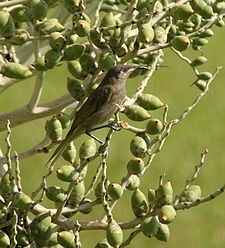- Grey-eared Honeyeater
-
Grey-eared Honeyeater Conservation status Scientific classification Kingdom: Animalia Phylum: Chordata Class: Aves Order: Passeriformes Family: Meliphagidae Genus: Lichmera Species: L. incana Binomial name Lichmera incana
(Latham, 1790)The Grey-eared Honeyeater or Dark-brown Honeyeater (Lichmera incana) is a passerine bird of the honeyeater family which is found in Vanuatu and New Caledonia in the south-west Pacific. It is sometimes known as the Silver-eared Honeyeater but this name is also used for the Silver-eared Honeyeater (Lichmera alboauricularis) of New Guinea.
Contents
Description
The Grey-eared Honeyeater is 13 to 17 cm long with the males being larger than the females. The plumage is mainly dull green-brown above and grey with an olive tint below. The cheeks are silvery-grey, and the crown is dark grey. The black bill is long and slightly downcurved; the legs and feet are blue-grey. Juveniles are paler than the adults without the silvery cheeks.
They are noisy birds which begin calling before dawn. They have a harsh 'tchoo-tchoo-tchoo' call and a warbling song.
Distribution and habitat
It is a common bird across most of its range and occurs in the lowlands and low hills in a variety of habitats including forest, scrub, mangroves and gardens. There are five subspecies; the nominate subspecies L. i. incana is found on Grande Terre, the main island of New Caledonia. L. i. poliotis and L. i. mareensis are found on the Loyalty Islands to the north-east. L. i. flavotincta and L. i. griseoviridis occur in Vanuatu.
Behaviour
Feeding
They feed from the shrub layer up to the canopy, moving from branch to branch in search of flowers from which they take nectar and pollen. They also feed on insects and spiders, searching among leaves or making short flights into the air to catch them. They will sometimes hover in front of flowers or spider webs looking for food.
Reproduction
The breeding season usually lasts from October to February. The nest is made mainly of grass and plant fibres, held together by spider webs. It is built in the fork of a branch in a tree or bush. Two eggs are laid; these are white with a few reddish spots and are incubated for 14 days. The young birds are fed on insects and spiders and leave the nest after 12 days.
References
- Bregulla, Heinrich L. (1992) Birds of Vanuatu, Anthony Nelson, Oswestry, England.
- Doughty, Chris; Nicolas Day, Nicolas & Andrew Plant (1999) Birds of the Solomons, Vanuatu & New Caledonia, Christopher Helm, London.
External links
Categories:- IUCN Red List least concern species
- Meliphagidae
- Birds of New Caledonia
- Birds of Vanuatu
- Animals described in 1790
Wikimedia Foundation. 2010.


